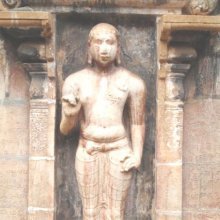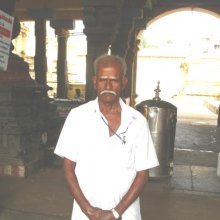Nayaṉmar, Nāyanmār, Nāyaṉmār, Nāyaṇmār: 3 definitions
Introduction:
Nayaṉmar means something in Hinduism, Sanskrit, Tamil. If you want to know the exact meaning, history, etymology or English translation of this term then check out the descriptions on this page. Add your comment or reference to a book if you want to contribute to this summary article.
Images (photo gallery)
In Hinduism
Vastushastra (architecture)
Source: Shodhganga: Temples of Salem region Up to 1336 ADNāyanmār.—The sculptures of all the sixty-three Shaiva saints popularly called as the Nāyanmārs are installed in twenty temples of the Śaiva creed. They are installed in the prākāramaṇḍapas. Their height usually varies from two feet to three feet.
Of these sixty-three saints, four saints referred to as Nālvar are installed separately in a few temples. They are
- Tirunāvukkarasu (Appar),
- Sundarar,
- Māṇikkavācakar,
- Tirunyānasambandar.

Vastushastra (वास्तुशास्त्र, vāstuśāstra) refers to the ancient Indian science (shastra) of architecture (vastu), dealing with topics such architecture, sculpture, town-building, fort building and various other constructions. Vastu also deals with the philosophy of the architectural relation with the cosmic universe.
General definition (in Hinduism)
Source: Oxford Bibliographies: HinduismThe term nāyaṉmār (singular, nāyaṉār) is a Tamil-language word that today generally means “leaders,” but as the term is widely known and used it specifically refers to sixty-three exemplary human figures in the Hindu devotional path of Tamil Shiva bhakti (devotion to the god Shiva), whose lives are described in a 12th-century volume attributed to Cēkkiḻār, the Periya Purāṇam (Great story), also known as Tiruttoṇṭar Purāṇam (The story of the holy servants).
The term nāyaṉār seems to have been first used in the 13th century to describe the three most famous male poet-saints (Campantar, Appar, and Cuntarar) in an inscription dated to the tenth regnal year of the Chola dynasty king, Rājendra III (1256 CE). The term nāyaṉmār may have been first expanded in the next century to refer to all of the devotees described in the Periya Purāṇam, in a text that purports to describe the making of the Tamil Shiva-bhakti canon.
The nāyaṉmār have a prominent presence in Tamil religious history as well as the present, wherever Tamils have settled across the globe—through their own compositions; biographical stories about them; their rendering in images including song, art, and film; and their incorporation into the lineage of the Tamil philosophical school, Shaiva Siddhānta. The nāyaṉmār are also fruitfully understood within the wider context of other bhakti poet-saints from Tamil tradition, as well as bhakti poet-saints from across India.
Languages of India and abroad
Tamil dictionary
Source: DDSA: University of Madras: Tamil LexiconNāyaṉmār (நாயன்மார்) noun < நாயன். [nayan.]
1. Lords, masters; தலைவர். [thalaivar.] (W.)
2. Gods; கடவு ளர். மற்றைத் திருப்பதிகளின் நாயன்மார்க்கும் [kadavu lar. marraith thiruppathigalin nayanmarkkum] (ஈடு-முப்பத்தாறுயிரப்படி [idu-muppatharuyirappadi], 7, 2, 11).
3. Canonized Śaiva Saints whose history is narrated in Periyapurāṇam; பெரியபுராணத்தில் வரலாறு கூறப்பெற்ற சிவனடியார். [periyapuranathil varalaru kurapperra sivanadiyar.]
Tamil is an ancient language of India from the Dravidian family spoken by roughly 250 million people mainly in southern India and Sri Lanka.
See also (Relevant definitions)
Full-text (+12): Periyapuranam, Civanatiyar, Pucalarnayanar, Cattinayanar, Ceruttunainayanar, Patal-perratalam, Necanayanar, Manakkancaranayanar, Murkkanayanar, Vayilarnayanar, Pacu-patinayanar, Tiru-nalai-povarnayanar, Munai-atuvarnayanar, Kot-pulinayanar, Tiru-nila-nakkanayanar, Tiru-kurippu-tontanayanar, Tirukkuttam, Comaci-maranayanai, Icainaniyar, Pukal-tunainayanar.
Relevant text
Search found 11 books and stories containing Nayaṉmar, Nāyanmār, Nāyaṉmār, Nāyaṇmār, Nayanmar, Naayanmaar; (plurals include: Nayaṉmars, Nāyanmārs, Nāyaṉmārs, Nāyaṇmārs, Nayanmars, Naayanmaars). You can also click to the full overview containing English textual excerpts. Below are direct links for the most relevant articles:
Pallava period (Social and Cultural History) (by S. Krishnamurthy)
Nayanmars during the Pallava period < [Chapter 3 - Socio-Religious Life]
Origin of Sculptural Art (c): Pallava period < [Chapter 2 - Origin of Sculptural Art—Its Development and Scheme]
Alvars during the Pallava period < [Chapter 3 - Socio-Religious Life]
Later Chola Temples (by S. R. Balasubrahmanyam)
Temples in Argal (Argalur) < [Chapter XII - Temples of Kulottunga III’s Time]
Temples in Kumbakonam < [Chapter IV - Temples of Vikrama Chola’s Time]
Appendix 2: Inscriptions in the Airavatesvarar temple at Darasuram < [Chapter VIII - Temples of Rajaraja II’s Time]
Temples in and around Madurantakam (by B. Mekala)
Appendix 3: Thiru Aatcheeswarar Temple Layout
Imperialistic Rule < [Chapter 2 - Temples: Role and Influence]
Bhakti Movement < [Chapter 2 - Temples: Role and Influence]
Middle Chola Temples (by S. R. Balasubrahmanyam)
Temples in Tirunelveli < [Chapter II - Temples of Rajaraja I’s Time]
Temples in Uttattur (Urrattur) < [Chapter IV - Temples of Rajendra I’s Time]
Temples in Tiruppainjili < [Aditya I]
Temples of Munnur (Historical Study) (by R. Muthuraman)
Introduction: Munnur Temple Economy < [Chapter 3]
Images of Jeshta (Jyestha) < [Chapter 5]
Early Chola Temples (by S. R. Balasubrahmanyam)
Devakoshta < [Chapter XIII - Prasada: Component Parts]
Temples in Erumbur (Urumur) < [Chapter II - Temples of Parantaka I’s Time]
Temples in Pullamangai (Pasupati Koyil) < [Chapter II - Temples of Parantaka I’s Time]

